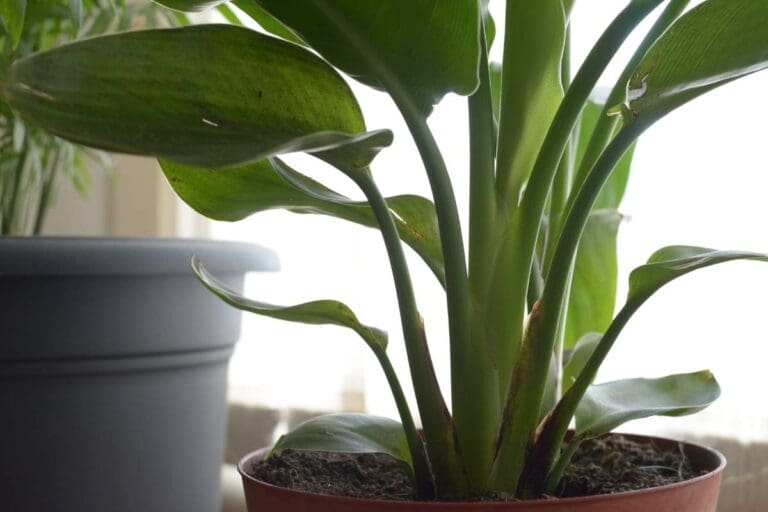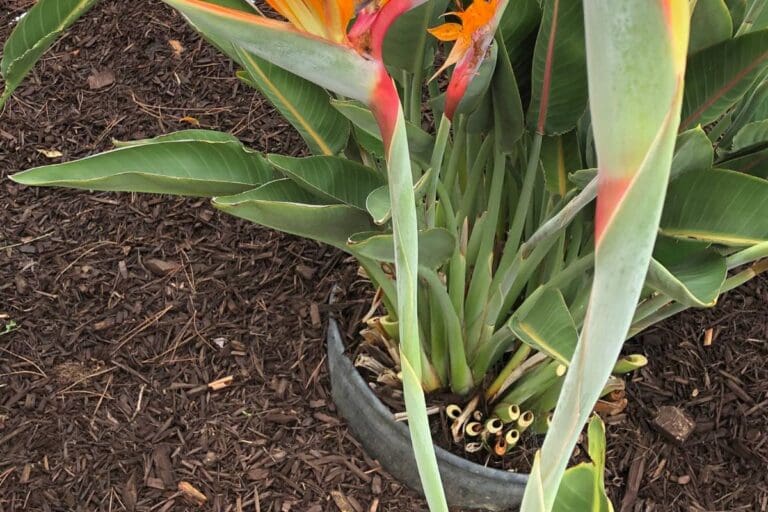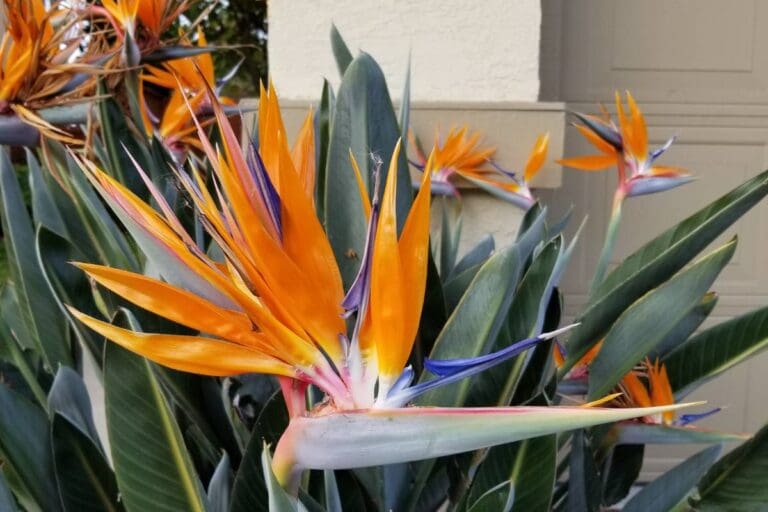Why Is My Bird of Paradise Turning Black? (7 Causes+Fix)
I know how bad it feels when one of your favorite houseplants, like a bird of paradise, starts turning black and loses its colorful charm. One of my houseplants faced this issue in the past, and I discovered my plant was suffering from root rot disease.
Birds of paradise can turn black due to pest infestations or fungal and bacterial infections. Powdery fungal mats germinating from sooty mold spores are the primary cause. To fix this, prune the affected parts, use a pesticide or fungicide on the plant, and provide the ideal growing conditions.
In this article, I will help you understand all the possible problems and solutions to fix your bird of paradise going black.

Please note: Simplify Plants is reader-supported. Some links in the post are affiliate links and I get a commission from purchases made through links in the post.
Causes of blackening in bird of paradise plants
Here, I am listing out 7 causes that can turn your bird of paradise black.
Later, we will discuss several fungal and bacterial infections in detail.
Let’s discuss these causes first. Shall we?
1. Overwatering
Both overwatering and underwatering can turn the leaves of your bird of paradise black.
How?
Bird of paradise hates to sit in water for a prolonged period, due to which the plant starts to rot, causing black spots all over the leaves, which later on spread to the entire plant.
Also read: How Much Water Does My Bird Of Paradise Need?
2. Poor drainage
Poor drainage can occur due to 2 main reasons, i.e., soil quality and drainage holes.
If the soil is extremely tight or the pot has fewer drainage holes, it can stay waterlogged for too long, so the oxygen flow doesn’t occur inside the soil properly.
Wet condition invites various fungus growth and root rot disease.
This leads to black leaves.
Also read: What Soil Should I Use For Bird Of Paradise?
3. Over-fertilization
Fertilizing is good, but only to a certain extent.
I have also made this mistake many times as I thought it would help my plant grow more.
But I didn’t know, and it harmed my plant in the worst possible way.
Over-fertilizing can burn your bird of paradise due to excessive salt accumulation in the soil, which turns the leaves black over time.
Also read: Do You Need To Fertilize Bird Of Paradise?
4. Excessive light exposure
Bird of paradise loves to thrive in indirect and direct sunlight but not the direct sunlight of peak afternoons.
Providing that kind of direct sunlight can burn your bird of paradise as it causes frequent dehydration even though you water it properly.
Direct light exposure can cause scorched, crispy, brown, and black leaves.
Also read: Can Bird Of Paradise Get Too Much Sun? (Sunburn)
5. Ant issues
Now, you might wonder how ants can cause black leaves on your bird of paradise.
It sounds a bit illogical.
But let’s make it logical by discussing the reason.
When pests feed the plant, they leave a sugary substance known as honeydew.
As you already know, ants are easily attracted to sweet substances.
When ants know that pests are responsible for discharging honeydew, ants try to protect them at any cost.
This encourages the pests to discharge honeydew even more, leaving the plant weak and eventually turning the leaves black.
6. Pest infestation
Pest infestation is the most common reason your bird of paradise turns black.
The common sap-sucking pests are mealybugs, aphids, spider mites, whiteflies, and scales.
The main motive of these pests is to suck out all the sap in the foliage.
The parts where the pests feed eventually turn black, leaving the plant completely weak.
7. Root rot

Root rot occurs due to overwatering, compact soil, and poor drainage.
This is one of the most dangerous diseases any houseplant can suffer from.
When the roots stay in water for an extremely long period, they develop various fungal growth, creating root rot disease.
Due to root rot, the roots fail to transfer water and nutrients to various parts of the plant, which causes stunted growth, thinner stem, and browning and blackening of leaves.
That’s why I never let my houseplant suffer from root rot.
You should also be careful.
Common fungal and bacterial infections in bird of paradise plants
Different types of fungal and bacterial infections can also cause black leaves in birds of paradise.
Let’s discuss the following:
Fungal infections
4 types of fungal infections can cause black leaves in birds of paradise, i.e., black spot, sooty mold, fungal leaf spot, and anthracnose.
Let’s go through all the infections.
1. Black spot
Black spot is caused by a fungus called Diplocarpon rosae.
When this fungus infects the plant, it produces black spots all over the infected parts.
Then that tiny black spot later spreads on the entire plant.
Once your bird of paradise becomes prone to this fungus, it can cause serious damage.
2. Sooty mold
Sooty mold appears when your bird of paradise is already suffering from pest infestations.
As you already know, sap-sucking pests leave a honeydew by excretion.
This honeydew attracts sooty mold, which helps develop powdery fungi.
The leaves develop a gray powdery coating if the sugary substance is too much.
Over time, sooty mold expands and covers the entire leaf with a black coating.
3. Fungal Leaf spot (Cercospora leaf spot)
Fungal Leaf spot is also a fungal disease caused by a fungus called Coleosporium spp.
The spores of these fungi usually stay in the air, and as soon as they find any wet conditions, they attack the plant and germinate quickly.
They mostly attack older foliage and develop black and brown spots on it.
Without treatment, these fungi can expand to the entire plant, worsening the situation.
4. Anthracnose
Anthracnose is a type of fungal infection where a wide variety of fungi attacks the plant all at once, causing black spots all over the leaves.
At first, you will see a small spot on the leaves, which then expands to huge black patches.
This fungus can also attack the stems of the bird of paradise, making it completely weak, and the plant can also end up dying.
Bacterial infection

There are 2 types of bacterial infection, i.e., bacterial blight and bacterial leaf spot, which can attack the bird of paradise and develop black patches on the leaves.
1. Bacterial blight
Bacterial blight is an infection caused by bacteria.
As a symptom, you will see dull and water-soaked patches on the stems and leaves.
As time goes by, the spots on the leaves turn completely black, and they eventually fall off.
This bacteria mostly stays on the soil surface, plant’s part, and seedlings.
2. Bacterial leaf spot
Bacterial leaf spot disease is caused by various bacteria that attack the leaves, causing black spots all over the infected areas, which later spread on the entire part.
This bacteria can also cause yellow or brown spots on the leaves, making them completely distorted and discolored.
Prevention and treatment of blackening in bird of paradise plants
If your bird of paradise turns black, you should immediately identify the exact cause and save your plant quickly.
Let’s discuss the solutions to each cause that we have discussed.
1. Treating watering problems
Here is how you fix a bird of paradise that has turned black due to overwatering:
- I immediately stop watering my plant. So, you should avoid watering until the bird of paradise recovers completely.
- Always keep your plant in bright indirect sunlight and provide proper aeration. It will let the extra moisture evaporate quickly.
- If the situation is bad, repot the bird of paradise. Take a pot 2-3 inches larger than the bigger one and a well-draining potting mix.
- Then, eliminate all the infected parts of your bird of paradise and keep it near bright indirect or direct sunlight after repotting.
- I never water my plant without checking the soil’s moisture level. You should also avoid doing this mistake. Use a moisture meter or insert a finger before you start watering.
2. Treating drainage problems
- The only option for improving the pot drainage is to change the current pot with a new one that has drainage holes.
- But to improve the soil drainage, you must add amendments to the current soil or change the soil, which is well-draining.
- Whenever I see compact soil, I try to improve its texture by adding perlite, sand, vermiculite, and crushed charcoal. You can apply any of the amendments to reduce the compaction.
- But from my point of view, the better option is to change the entire soil. I know the procedure becomes complicated, but trust me, it’s worth it.
- Mix equal parts of potting soil, peat moss, and some perlite or bark to make it well-draining, and re-pot it by eliminating the old soil.
3. Treating excessive light exposure

- Eliminate all the burnt, scorched leaves from your bird of paradise and provide proper watering little by little to make the plant hydrated.
- Place your plant where it will receive direct or indirect light but not too direct. I place my houseplants mostly in the east-facing windows. It’s the best possible location.
- When placing your plant near a window, always keep a distance of 5 feet and provide sheer curtains to reduce the light intensity.
4. Treating over-fertilization
- When you notice your bird of paradise is over-fertilized, avoid fertilizing until the plant recovers.
- If you see salt accumulation on the soil surface, water the soil thoroughly until the salt washes out from the drainage holes.
- Even if it doesn’t work, I suggest you completely re-pot your bird of paradise using fresh new soil.
- Always fertilize the bird of paradise during its growing season, i.e., spring and summer.
- For fertilizing, the best way is to use a well-balanced diluted liquid fertilizer.
- I always water my houseplants before fertilizing them to spread them completely on the soil.
5. Treating pest infestation
- Whenever my plant suffers from pest infestations, I immediately isolate my houseplants. So, keep the bird of paradise far away from other houseplants.
- Remove all the infected parts of your bird of paradise.
- If you notice any visible pests, pick them up with your hands. Wear gloves while doing this.
- Then, give a proper shower to your bird of paradise to remove all the remaining pests. You can use dish wash or insecticidal soap for spraying. Don’t forget to read the instructions.
- Even after washing, if pests are still stuck on your plant’s part. Dip cotton balls into the rubbing alcohol, and wipe off the infected parts.
- To prevent further infestations, use biological pesticides every 2-3 weeks. Don’t ever use chemical pesticides on your bird of paradise as they are sensitive to them.
6. Treating root rot
- Immediately remove your bird of paradise from the pot and wash the roots to remove all the attached soil.
- Then look at how much the roots have been infected and get rid of them quickly using well-sterilized pruners.
- Then prune all the black leaves and stems.
- Bring a new pot 2-3 inches bigger than the previous one and the fresh, well-draining soil mix.
- Then, re-pot the plant on the new pot using a fresh soil mix. Make sure the pot has a good amount of drainage holes.
- Then water the plant thoroughly until it comes out from the drainage holes. This will help the roots to set up with the soil completely.
- Avoid watering again until the soil dries out completely.
7. Treating fungal infections
- Remove all the damaged leaves and stems by using sterilized pruners. Then, throw away the waste.
- Look for the pests which may have infected your bird of paradise. Then, take a brush and scrub the honeydew.
- To completely get rid of the fungi, you should use a fungicide. Neem oil is the best natural fungicide. I also use this for my houseplants.
- You can also use baking soda. It helps you to kill all the fungi immediately.
- Provide your bird of paradise with proper indirect light, aeration, and humidity, and always water the plant from the base but not the top.
- Once you have pruned the leaves, always wash the pruners so the infections will not spread to other houseplants.
8. Treating bacterial infections
- First, remove all the damaged leaves of your bird of paradise using sterilized pruning shears.
- After eliminating the affected parts, add bactericide all over the bird of paradise for further treatment.
- You can use a horticulture oil or copper sulfate fungicide to treat the plant. Don’t forget to read all the instructions before applying.
- Bacteria mostly thrive in low light, high humidity, and wet conditions. So, avoid providing these conditions to your birds of paradise.
- If the humidity always stays high in your area, install a dehumidifier for your plant.
- Avoid watering the leaves. I always water my plant only on the soil surface.
- After you are done, throw all the affected parts far away from the plants to avoid further infections.
Tips for maintaining a healthy bird of paradise plant

Here are some tips for maintaining your bird of paradise:
| Factors | Prevention tips |
|---|---|
| Location | Keep your bird of paradise where it will receive good air circulation. Also, prune the plant properly to regulate good airflow. |
| Water | Before watering, always use a moisture meter or insert a finger to check the soil’s moisture level. Water it only when the topsoil is dry. |
| Humidity | To maintain humidity, you can mist the plant frequently by spraying, using a humidifier, or applying a pebble tray method. In case you want to reduce the humidity, use a dehumidifier. |
| Sunlight | Birds of paradise thrive in direct and indirect sunlight. But always protect the plant from harsh sunlight. |
| Fertilizer | Fertilize the bird of paradise with a well-balanced liquid fertilizer only during spring and summer. |
| Fungus and pests | When you notice pests and fungal infections, prune the infected parts and spray Neem oil all over the plant. Repeat it every 2-3 weeks. |
| Winter Care | Avoid frequent watering, fertilizing, and pruning during winter months. |
| Repotting | Bird of paradise needs repotting after 18-24 months. Always use new potting soil and choose a pot 2-3 inches larger than the previous one. |
Final words
When I first saw black leaves for the first time on my houseplant, I started panicking as everyone did. But it doesn’t solve any problem. When you notice your bird of paradise is turning black, it indicates something is wrong, and you should immediately solve this problem.
I have discussed all the possible issues and their solutions in this article. Go through them patiently and try to understand the issue with your bird of paradise.
Can you recover the already damaged black leaves?
No, it is impossible to recover the black leaves and bring them into their green pigment. The only option is to get rid of it by pruning.
What are the early signs of black leaves?
Yellow leaves are the early signs of black leaves. You will never see your plant turning black all of a sudden. At first, the leaves will turn yellow, then brown, and at the final stage, they will turn completely black.
Reference: Wikipedia
Recommended Garden Supplies
| Product Image | Our Recommended Gardening Supplies | Check Offers! |
|---|---|---|
Top Top
Top
Top
Top
Top
Top
Top
Top | rePotme Houseplant and Tropical Classic Potting Soil Mix | Check Offer On Amazon |
 Top
Top
Top
Top
Top
Top
Top
Top | Espoma Organic Indoor Plant Food | Check Offer On Amazon |
 Top
Top
Top
Top
Top
Top
Top
Top | GooingTop LED Grow Light 6000K Full Spectrum Clip Plant Growing Lamp | Check Offer On Amazon |
 Top
Top
Top
Top
Top
Top
Top
Top | Soil Moisture Meter | Check Offer On Amazon |
 Top
Top
Top
Top
Top
Top
Top
Top | Govee Hygrometer Thermometer, Bluetooth Enabled! | Check Offer On Amazon |
 Top
Top | LEVOIT Humidifiers for Large Room(Best For Plants) | Check Offer On Amazon |
 Top
Top
Top
Top
Top
Top
Top
Top | Upgraded DIY Automatic Drip Irrigation Kit, 15 Potted Houseplants Support | Check Offer On Amazon |
 Top
Top
Top
Top
Top
Top
Top
Top | Stainless Steel Heavy Duty Gardening Tool Set | Check Offer On Amazon |
 Top
Top
Top
Top
Top
Top
Top
Top | Bonide Insecticidal Soap | Check Offer On Amazon |
 Top
Top
Top
Top
Top
Top
Top
Top | Bonide 32 oz Spray Neem Oil for Organic Gardening | Check Offer On Amazon |
 Top
Top
Top
Top
Top
Top
Top
Top | Garden Safe Fungicide | Check Offer On Amazon |





